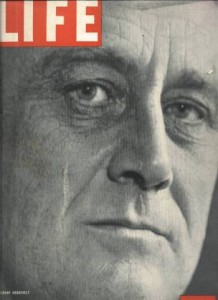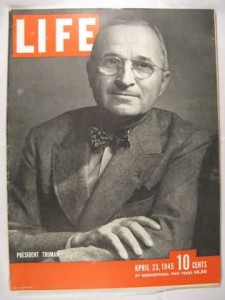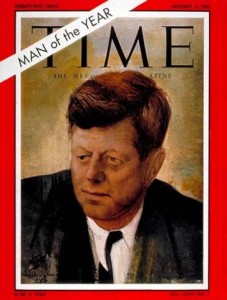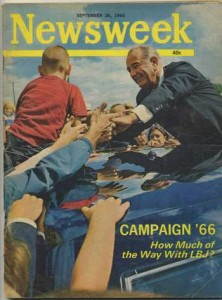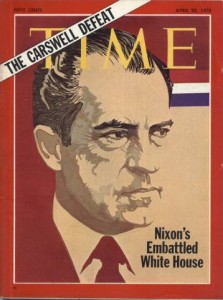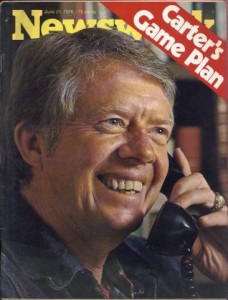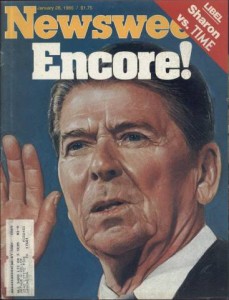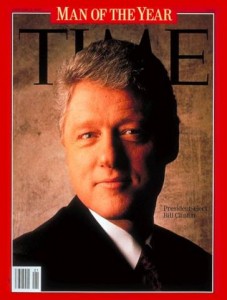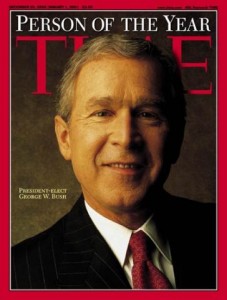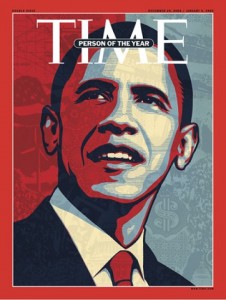The late President Dwight D. Eisenhower is featured on the April 7, 1969 cover of Newsweek. Ike passed away on March 28, so that gives a pretty good general idea of Newsweek’s lead time.

I don’t know if it’s because of Eisenhower’s death or a more general response to the times, but I found this issue of Newsweek heavily nostalgic. By this I mean that they were looking back fondly on the mid-Twentieth Century in 1969. And paging through thirty years after the cover date I’m fascinated by the idea that America then, more specifically Newsweek’s editorial team which represents at least a portion of its large number of subscribers, was looking back on fonder times.
It starts even before we reach the cover story with a small piece titled “The Birth of Rock.” Granted, it’s under the heading Where Are They Now? but the text of the article clearly describes a retro 50’s affinity from Bill Haley in 1969. The “Rock Around the Clock” singer was 42 years old in ’69 and says of his fans, “It’s the same kids. But then they weren’t old enough to get into nightclubs. So now that they are, they want to hear what they liked then.
Haley hasn’t completely frozen himself in time. Along with what remains of His Comets Haley has released a country and western record and keeps an appearance similar to that of his fans–clean shaven with his curly hair cut short. Of the comeback Newsweek writes “nostalgic 30-year-olds are rocking to the group’s sound in nightclubs across the country, trying to recapture the buoyant rhythms of their youth.”

Later inside the same issue under the heading Morals, an article begins “A rock singing group called “The Doors” opened in Miami one evening early last month, and in the course of the performance … a 24-year-old singer named Jim Morrison comported himself as follows … Morrison did lewdly and lasciviously expose his–”
We’ll stop there, I think you know what comes next. After all of the details Newsweek goes on to lament the permissiveness of society in general and follows up The Doors section with a write-up of the controversial new play Che, whose entire cast would be hauled into court on charges of “consensual sodomy, public rudeness and obscenity.”
After that you can almost hear Bill Haley sigh and wish for simpler times while reading the article in tribute to Eisenhower, which opens:
He seemed a figure of a simpler, tidier past-a past now so distant in remembrance that it was hard to believe he had departed the White House only eight years ago. Dwight David Eisenhower’s America was a place where a war could be called a crusade and a smile could be an act of public policy, where the forces of darkness were lodged immutably in the Kremlin and a domestic demagogue as uncivil as Joe McCarthy could simply be ignored into oblivion.
Of the times which mourns Eisenhower Newsweek comments that it is “a smaller, more dangerous and far less innocent place, striving incredibly for the moon yet so constricted that no guerrilla raid was too remote and no border fight too petty to set shivers running around the latitudes.”
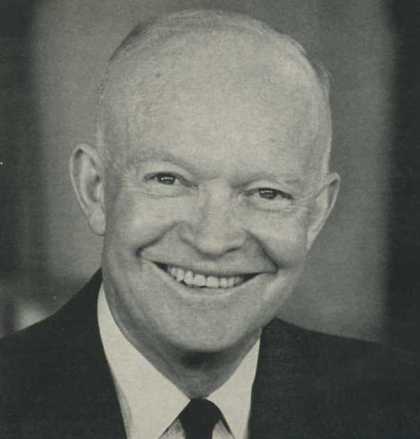
Despite all this nostalgia it is actually the Nixon Administration which is looking forward. In this case planning ahead to the end of their second term by assigning Oklahoma football coach Bud Wilkinson to start getting things ready for the bicentennial celebration to be had in ’76.
Back in 1969 though, Nixon is just over two months in office and trying to skate through his first 100 days without addressing the rising battlefield deaths in Vietnam. Nixon, in fact, had hoped for a six month grace period, but the early criticism caused him to address the National Association of Broadcasters in Washington and hint that secret negotiations with North Vietnamese officials had begun.
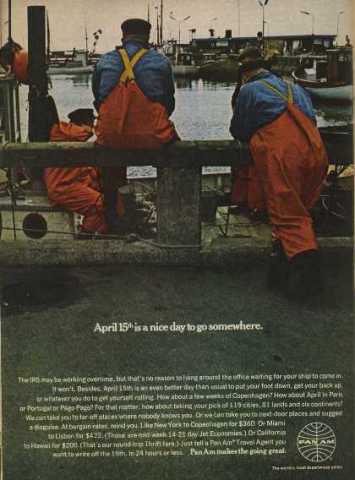
Chaos reigns in the heavyweight division in boxing where WBA champ Jimmy Ellis is kept from the best competition and a young “white hope,” Jerry Quarry hopes to do battle with Joe Frazier. But Ali looms with the potential of righting the entire division. It’s expected that Frazier will take care of Quarry and by that time Ali will be reinstated to fight Frazier later in ’69. In Newsweek’s words, “Ali seems to have a real chance to escape jail and return to action…”
Another look back to the past in the Business section where Newsweek revisits the beginnings of Air Mail in 1918, when the U.S. Post Office launched regular service between New York and Washington. The first flier of that route crashed and the air mail actually reached New York by train. Very quickly though the service grew and airmail was contracted out to private aviator firms, led by Henry Ford’s five-monoplane line.
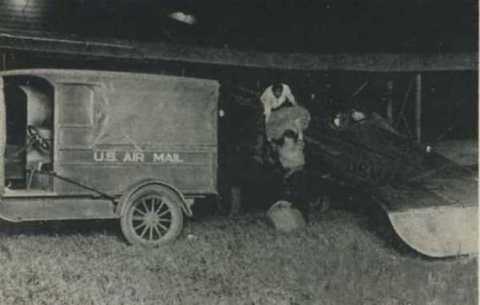
But as time went by, the revered names vanished along with the silk scarves, skull-tight helmets and goggles. In their place appeared the massive and impersonal commercial airlines, which now handle 80 per cent of all first-class letter mail in the U.S. (whether it’s marked airmail or not).
But the Post Office is bringing back the small planes with 35 air-taxi companies flying mail over 151 routes inside the continental U.S., with another 60 routes to be added in June 1969.
The routine of a typical pilot working for the Post Office, Don Bookout, is described:
…takes off every night, except Saturday, at 7 from the copper-mining t0wn of Ely, Nev. (population: 7,250) with 600-odd pounds of mail. He flies his twin-engined Piper Aztec to Elko, Nev., 118 miles away, pauses there for ten minutes to unload and load mail, then takes off again on instruments for Reno. There he switches to a larger place, a DeHavilland Dove, and takes off again, at 9:50 for the 113-mile flight over the snow-capped Sierra Nevada to Sacramento, Calif. He stops there for 45 minutes, then flies on to San Francisco with what has now become a load of 2,700 pounds of mail.
After retracing his course, Bookout returns to Ely at 6:20 am for breakfast. He’s paid a base salary of $850 per month plus a $250 monthly bonus for flying six days per week.
Finally, the obituary section notes the passing of B. Traven, or at least Traven Torsvan Croves, formerly Hal Croves, who may or may not have been writer B. Traven, best known as the author of The Treasure of the Sierra Madre which was made into the classic 1948 film by John Huston. Huston had thought Croves was Traven, as Croves was on location for filming of Treasure in 1947, but Croves was there as Craven’s agent. Wikipedia actually has a very detailed page with several of the B. Traven theories, check it out if this sparked your interest any.

And that closes another old magazine back issue. I find the nostalgia of Newsweek during its more left-leaning Katherine Graham times interesting. On my page about the history of Newsweek I wrote, “Newsweek distinguished itself from Time during the 1960’s by appealing to younger readers through their presentation of the two big stories of the period: race relations and angst over Vietnam.” I suppose as a publication still interested in appealing to mainstream America, Newsweek remained far from revolutionary, but putting my hands-on this particular issue, my actual experience doesn’t jibe with my previous research. As we surely page through more issues of Newsweek in the future I’ll be curious to see if they also remember the past so fondly.
